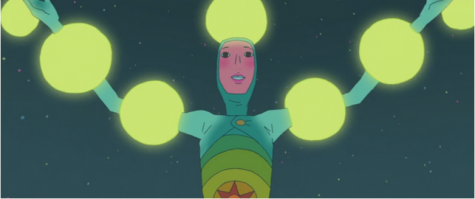Movie Monday with Luke: “Mind Game” profoundly motivating
October 12, 2015
This column is in desperate need of some positivity, but no fear; this week I’ll be giving a positive review to a positive movie. It’s one of Netflix’s greatest (and few) hidden gems.
“Mind Game” is a surreal 2004 Japanese animated film directed by Masaaki Yuasa, who is known for making films and TV series you’re more likely to be called an animation nerd than a weeaboo for liking. The film is based on a manga of the same name by Robin Nishi, which remains even more obscure than the film. It’s about life. Or at least, what could be life.
“Mind Game” follows a young man named Nishi, whose life is in shambles…what little life he has, that is. His dream of becoming a comic artist is going nowhere and his other dream of going out with his lifelong crush, the sweet and voluptuous Myon, is decimated by her plans to marry her hotshot fiancee Ryo. Meeting at Myon’s family-owned restaurant, run by her timid and lifeless older sister Yan, the gang’s unhappy night is interrupted by an encounter with a couple of Yakuza, leaving Nishi dead. Finding himself at the bridge between “heaven” and earth, Nishi makes a run for earth and winds up with a second shot at conquering that fateful moment. The series of events that follows sends him and the sisters inside a whale, where they find an old man who’s been living there for thirty years and the free, luxurious getaway he’s built for himself. Should they stay? Should they leave? Do they have a choice?
The first thing that will strike you about “Mind Game” is that it doesn’t look like an anime film at all. Movements and character designs are exaggerated far beyond the confines of most anime, emphasizing each character’s emotions and intentions. The main character of the film comes off as full of willpower because of the way he moves. He runs like a cheetah desperately trying to go even beyond its amazing speed, with his muscles and face contorting along the way. While the fluid art style aides in characterization, it doesn’t mesh well with the odd artistic choice of planting live-action faces on the characters during close-ups, seeing as everything else is so unrealistic. It would make sense if these close-ups only showed up in serious scenes meant to contrast the cartoony nature of the rest of the film, but instead they’re randomly mixed into the cartoony scenes, slowing them down substantially. Apparently the crew realized this didn’t work well relatively quickly, as the real-life close-ups stop appearing for the most part after the first act, making the the film’s art rather uneven and inconsistent overall.
The film goes beyond its main art style in more successful ways later on. For example, whenever the movie wants to portray any sort of happiness in its characters, the colors become unstable. A dancing scene sees the characters with more simplistic, loosely-defined designs (at some points you could easily mistake Nishi for Gumby), quicker animation and solid colors flashing along with their wild movements. This intentionally evokes a frantic, artificial, desperate sort of happiness. A different scene sees two characters getting completely enveloped in a mixture of colors to the point where you can only tell they are human by their movements. This intentionally comes off as pure, genuine euphoria. It’s the careless, pointless “freedom” of the whale vs. love and potential. The movie knows how and when to be artificial and how and when to be genuine in order to silently communicate what each character is feeling and why. This is the kind of thing that should separate a film from a book.
The animation in this movie is plenty notable, but if you think the whole film is just an excuse to show off some weird animation, you’re wrong. The weird animation is a tool used to exaggerate the importance of each character and each event, polishing the film’s way of telling its story. The film tries to get its messages of “the future is precious” and “the best thing you can do in life is make an impact” across in ways that make for some very unconventional storytelling. One is by using second chances as a plot device. In two separate instances, the film derails itself by rewinding and letting a character make a different choice than they made before, completely changing the events previously shown. The first time, the chance is brought about by the main character’s willpower. The second time, it’s brought about by nothing, simply appearing to show how far a single choice can go.
Another way the movie gets across its messages is by keeping a high amount of focus not on what is or what will be, but rather on what could be. The main conflict of the movie is “Should I stay or should I go?” It provides pros and cons for both answers, the latter through the use of a fantasy world modeled after the characters’ persistent dreams: Nishi’s comic drawing and Myon’s swimming. In Yan’s case, her plight is more general: to become…some kind of thing. Her role in the fantasy world is nigh indescribable. The conflict is more real for her than anyone else; in the first act, she comes off as little more than a background character. Hardly speaking, never interfering, stuck building up waste in her mind. The whale gives her the freedom to experiment with the contents of her full-to-burst mind to her heart’s content. She dances about like a maniac, clothed in paint and balloons. Without a real talent other than mindless labor, could that be the best her life gets? The film is smart enough to know that the viewer won’t get anything out of a simple yes or no answer; it’s all about highlighting the massive myriad of possibilities awaiting a creative mind willing to step outside, showing them off in beautifully convoluted fashion.

One more way the movie gets across its messages is by showing that every single little act committed by the characters throughout their entire lives helped bring about the later events of the story. Near the beginning and at the very end of the movie, lengthy yet ultra fast-paced montages are shown that mix together events of the lives of almost every character in the film and basically explaining why everything started. It shows where all the characters’ problems came from not by antagonizing anyone, but by showing what caused everyone to become problems for each other. They all did good things and they all made mistakes, and every one of those contributed to the future. That’s life, and that’s why the characters are so easy to get invested in. Even though the events of the movie are fantastical in nature, the timeline they inhibit is structured in an ultra-realistic fashion. Don’t expect cartoon continuity here.
SHOULD YOU WATCH IT? It’s an audacious effort that caters to hardcore animation fans over casual audiences, but I’d still recommend it to anyone who doesn’t want to get out of bed. With a fun, meticulous and truly special way of storytelling to push its message of potential, “Mind Game” is a profoundly motivating experience.
WATCH IF YOU LIKE: 2006’s “Paprika,” the similarly touching, stunning and weird final finished effort of the late and great Satoshi Kon. Also watch if you’re looking to continue an eye-watering animated film binge on Netflix that started with Don Hertzfeldt’s “It’s Such A Beautiful Day” from 2012.


